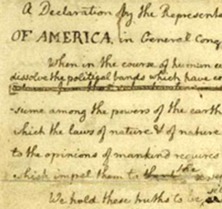REBELLION: 1775-1776

What we call the American Revolution became a revolution by virtue of the Patriots' victory in 1781. Until then, it was a rebellion—factions fighting each other with words and weapons. In this Theme we follow the American rebellion as it turned into outright war in 1775 and 1776. Sections 1-4 consider the civil war between Patriots and Loyalists in the north, south, and backcountry. Section 5 views the struggles of religious pacifist groups as they sought tolerance as conscientious objectors to war. Section 6 examines the debate over slavery at a time when white men, including slaveholders, were declaring that "all men are created equal." Sections 7-8 focus on the critical year of 1776 when many colonists abandoned hope for reconciliation with Britain and embraced the goal of independence. We examine two documents that exerted inestimable influence in achieving this transition in 1776—Common Sense by Thomas Paine, and the official statement of rebellion, the Declaration of Independence.
Sections in REBELLION
Each section presents primary resources, introductory notes, classroom discussion questions, and supplemental links.
- Loyalists I: Civil War
- - Loyalists at the outbreak of war: selections from letters and commentary, 1775-1776
- - A Loyalist's poem: Rev. Myles Cooper, "The Patriots of North America," 1775, selections
- Loyalists II: "Traitor!"
- - Anti-Loyalist broadsides and blank forms of allegiance, 1775-1776
- - Anti-Loyalist violence, 1774-1775: incidents compiled by Peter Oliver, Origin and Progress of the American Revolution, 1781
- - "My Kinsman, Major Molineux," short story by Nathaniel Hawthorne, 1830, depicting anti-Loyalist violence in pre-revolutionary Boston
- Loyalists III: Join—or Else
- - On the treatment of Loyalists in Virginia, travel journal of Nicholas Cresswell, 1774-1777, selections
- - On the treatment of Loyalists in North Carolina, travel letters of Janet Schaw, 1775, selections
- Loyalists IV: Backcountry
- - Recruiting backcountry settlers to the Patriot cause, reports to the South Carolina Council of Safety, 1775, selections
- The Pacifists
- - Pacifists' appeals for tolerance in the first years of the Revolution, 1775-1778
- The Enslaved
- - Six appeals for abolition, 1773-1783, excerpts
- - Petition to end slavery in Massachusetts, 1777
- - The anti-slavery clause in Jefferson's draft of the Declaration of Independence, 1776
- Common Sense?
- - Thomas Paine, Common Sense, 1776, selections
- - Praise for Common Sense in American newspapers, 1776
- - A Loyalist response to Common Sense: Rev. Charles Inglis, The Deceiver Unmasked, 1776, selections
- - A poem on Common Sense: Hannah Griffitts, "Upon reading a Book entitled Common Sense," 1776
- - John Adams looks back on Common Sense, Autobiography, early 1800s, selection
- Declaring Independence
- - The Declaration of Independence, 4 July 1776, annotated
- - Delegates' letters on the Declaration, July 1776
- - News accounts of celebrations of the Declaration, 1776
- - A Loyalist's rebuttal of the Declaration: Thomas Hutchinson, Strictures Upon the Declaration . . . , 1776, selections
Framing Questions
- What rebellions and "civil wars" occurred within the colonies as war approached in the mid 1770s?
- How did colonists express and debate their differing opinions?
- How did they deal with political opponents?
- What caused the moderate voice to fade from the political arena?
- What led Americans to support or oppose the ultimate goal of independence?
Images:
Banner Image: Original Declaration of Independence, parchment, 1776 (detail); on exhibit in the Rotunda of the National Archives, Washington, DC. Courtesy of the U.S. National Archives and Records Administration.
Block Image: Thomas Jefferson, manuscript draft of the Declaration of Independence, June 1776, p. 1 (detail). Courtesy of the Library of Congress, Manuscript Division.



